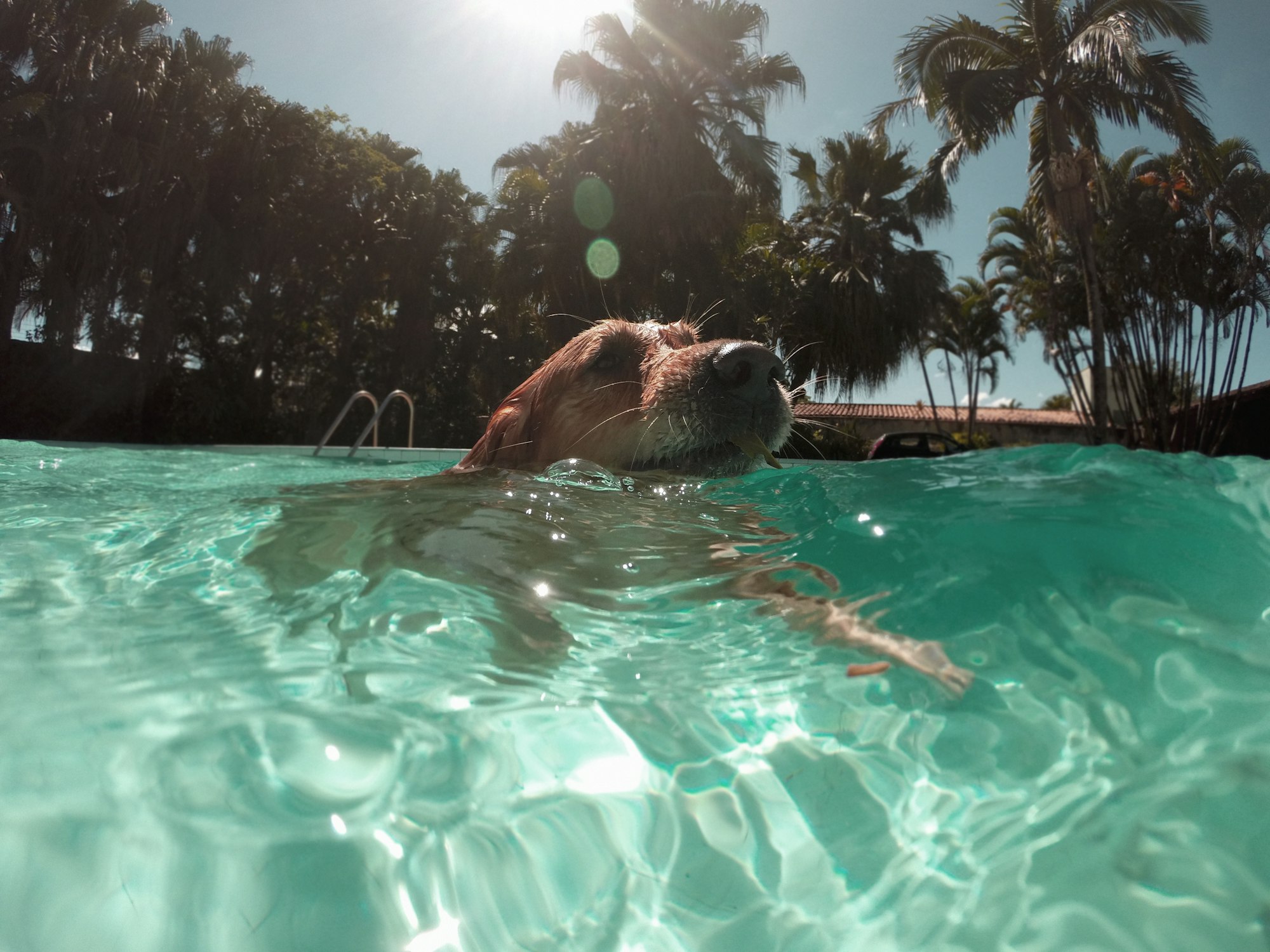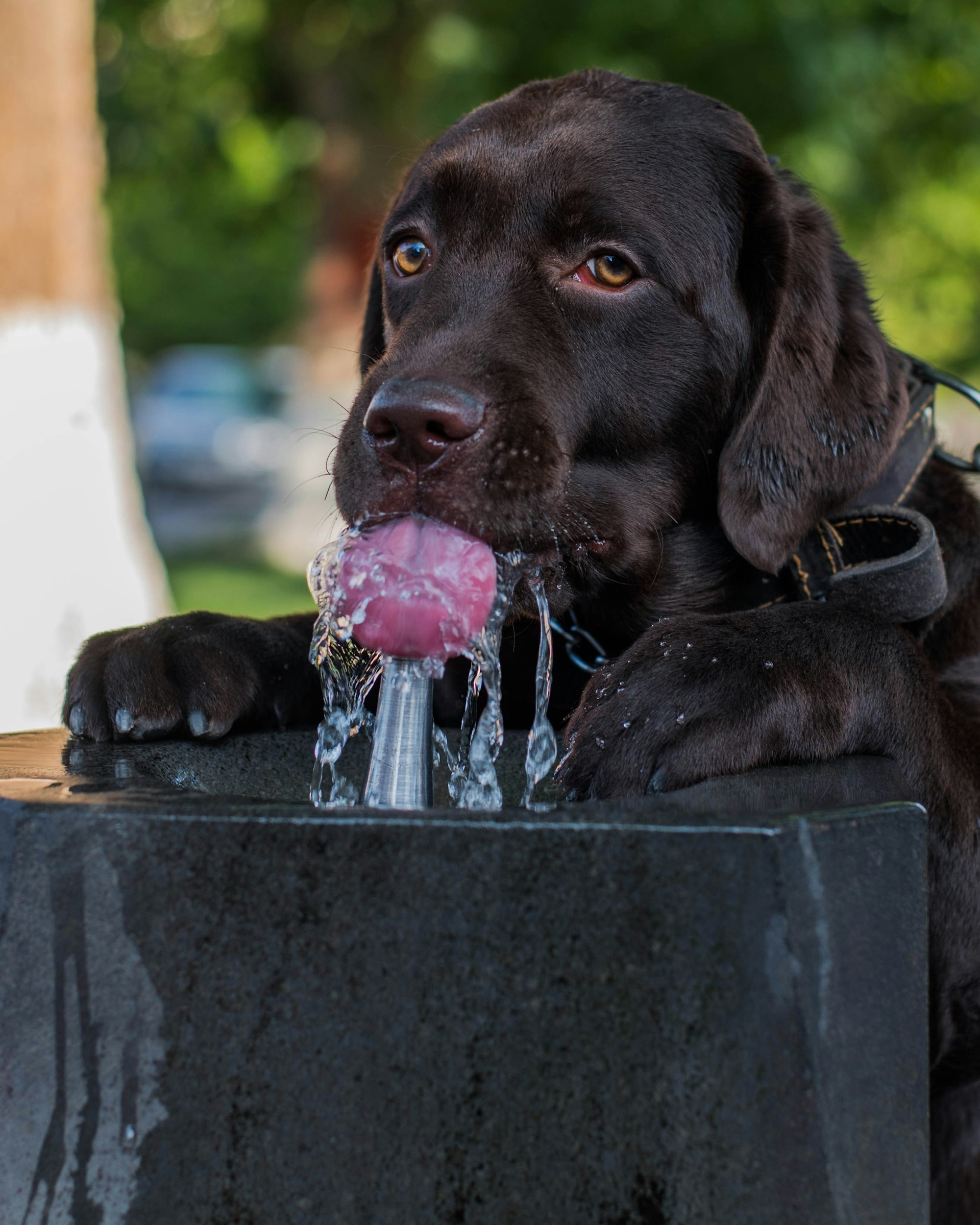Dogs are not immune to the effects of hot weather. As responsible pet owners, it's crucial to know how to keep our furry friends safe and comfortable during scorching summer days or after intense physical activities. One of the key aspects of canine care is learning how to cool down a dog effectively. In this comprehensive guide, we will explore the science behind cooling down dogs, the signs of overheating to watch out for, and various methods to ensure your canine companion stays cool and healthy.

Signs of Overheating in Dogs
Heat-related issues in dogs can be life-threatening, making it essential for pet owners to be vigilant and recognize the signs of overheating in their canine companions. Understanding these signs is crucial in ensuring the well-being of your pet, especially during hot weather or after vigorous physical activities.
1. Excessive Panting:
One of the primary indicators of overheating in dogs is excessive panting. While panting is a natural way for dogs to regulate their body temperature, excessive and rapid panting, especially when accompanied by a widened tongue and drooling, can be indicative of distress.
2. Elevated Body Temperature:
In cases of overheating, a dog's body temperature rises significantly beyond the normal range of approximately 100.5 to 102.5 degrees Fahrenheit (38 to 39.2 degrees Celsius). Measuring your dog's temperature with a rectal thermometer can help confirm overheating.
3. Weakness and Lethargy:
An overheated dog may exhibit weakness, lethargy, or a lack of coordination. These signs indicate that the body is struggling to cope with the elevated internal temperature.
4. Rapid Pulse and Heart Rate:
Monitoring your dog's pulse and heart rate is essential when assessing their condition. A rapid heart rate is often a sign that the dog's cardiovascular system is working overtime to cool down the body.
5. Vomiting and Diarrhea:
Heat stress can lead to gastrointestinal distress, causing symptoms such as vomiting and diarrhea. Dehydration often accompanies these symptoms, exacerbating the dog's condition.
6. Bright Red Gums and Dry Nose:
The color of the gums can serve as an indicator of overheating. Gums that appear bright red or dry can be a sign of heat-related distress. A dog's nose may also become dry and warm in such situations.
7. Collapse or Loss of Consciousness:
In severe cases of overheating, a dog may collapse or lose consciousness. This is a critical emergency, and immediate veterinary attention is imperative.
The Science Behind Cooling Down
Understanding how dogs regulate their body temperature provides valuable insights into the science behind cooling them down effectively. Unlike humans, who have an extensive network of sweat glands, dogs primarily dissipate heat through panting and limited sweating through their paw pads. This unique physiological difference makes them more susceptible to overheating.
1. Panting as a Cooling Mechanism:
Panting is the primary means by which dogs release excess heat. When a dog pants, moisture evaporates from the moist surfaces of their mouth, tongue, and upper respiratory tract. This evaporative cooling helps reduce their body temperature.
2. Limited Sweat Glands:
Compared to humans, dogs have relatively few sweat glands, primarily located in their paw pads. While these sweat glands contribute to cooling, their impact is limited, making panting the primary cooling mechanism.
3. Temperature Regulation Challenges:
Dogs can quickly become overwhelmed by excessive heat, as their cooling mechanisms have their limits. When the environmental temperature rises significantly, or when humidity is high, dogs can struggle to cool down effectively, increasing the risk of overheating.
4. Importance of Hydration:
Maintaining proper hydration is critical for dogs to regulate their body temperature. Water is essential for facilitating heat dissipation through panting and maintaining overall well-being.
5. Cooling Down Methods:
Understanding the science behind cooling down dogs informs the choice of effective methods. Providing shade, access to fresh water, and using cooling mats or damp towels can aid in heat dissipation.
Effective Methods to Cool Down Your Dog
Cooling down a dog, especially during hot weather or after vigorous physical activity, is essential for maintaining their well-being and preventing heat-related issues. Understanding and implementing effective methods to cool down your canine companion is a fundamental aspect of responsible pet ownership.
1. Providing Shade and Fresh Water:
- One of the most straightforward yet crucial methods for cooling down a dog is to ensure they have access to shade and a constant supply of fresh water. Shade provides respite from direct sunlight, reducing the risk of overheating. Fresh water is essential for facilitating evaporative cooling through panting and preventing dehydration, which can exacerbate heat stress.
2. Using Cooling Mats and Towels:
- Cooling mats and damp towels can be invaluable tools for lowering your dog's body temperature. Cooling mats are designed to absorb and dissipate heat from the dog's body when they lie on them. Similarly, draping a damp, cool towel over your dog or gently wiping them down can help promote heat dissipation.
3. Offering Frozen Treats:
- Dogs appreciate frozen treats, especially during warm weather. Preparing dog-safe ice cubes using low-sodium broth or freezing fruits like berries can provide a refreshing and enjoyable way for your dog to cool down while staying hydrated.
4. Taking Shorter Walks in Hot Weather:
- Adapting your dog's exercise routine during hot weather is essential. Opt for shorter walks during cooler times of the day, such as early morning or late evening. Avoid exercising your dog during the hottest hours to prevent overheating.
Understanding that dogs have limited heat-dissipation mechanisms, these methods become even more critical. By providing shade, cooling mats, frozen treats, and adjusting exercise routines, responsible pet owners can significantly contribute to their dog's comfort and safety.

In conclusion, implementing effective cooling methods for your dog is not only a matter of comfort but also a vital aspect of their overall well-being. Being proactive in providing shade, hydration, and cooling aids can help ensure that your canine companion remains cool, comfortable, and healthy, even in the most challenging of environmental conditions.
Avoiding Common Mistakes
Heat-related issues in dogs can be life-threatening, and responsible pet owners must be aware of common mistakes that can exacerbate these conditions. By avoiding these errors, you can significantly reduce the risk of heat stress, heatstroke, and related complications in your canine companion.
1. Never Using Ice Cold Water:
One common misconception is that using ice-cold water to cool down a hot dog is effective. However, this approach can actually be counterproductive. Sudden exposure to very cold water can constrict blood vessels and lead to shock. Instead, use cool, not ice-cold, water to gradually lower your dog's body temperature.
2. Not Considering Your Dog's Breed:
Different dog breeds have varying tolerances to heat. Brachycephalic breeds like Bulldogs, with their flat faces and compromised respiratory systems, are particularly vulnerable to overheating. It's crucial to be extra cautious with these breeds and limit their exposure to high temperatures.
3. Ignoring Warning Signs:
Ignoring the early signs of overheating is a grave mistake. When a dog exhibits symptoms such as excessive panting, drooling, weakness, or a rapid pulse, immediate action is required. Ignoring these signals can lead to severe health complications, including heatstroke.
4. Leaving Dogs in Parked Cars:
Leaving a dog in a parked car, even with cracked windows, can lead to life-threatening heat buildup within minutes. This common error can result in heatstroke, organ failure, or even death. Dogs should never be left unattended in vehicles during hot weather.
5. Lack of Proper Hydration:
Inadequate hydration can significantly contribute to overheating in dogs. Failing to provide access to fresh water, especially during hot weather or strenuous activities, can lead to dehydration, making it more challenging for dogs to regulate their body temperature.
By avoiding these common mistakes and adopting responsible pet care practices, dog owners can significantly reduce the risk of heat-related issues. Understanding that dogs have limited heat-dissipation mechanisms and respecting their unique needs is paramount. By providing appropriate care and attention, you can ensure your canine companion remains safe and comfortable, even in challenging environmental conditions.
In conclusion, responsible dog ownership entails being aware of common mistakes that can jeopardize your pet's well-being, particularly in hot weather. By avoiding these errors, you can promote a safe and healthy environment for your dog, minimizing the risk of heat-related complications.
Cooling Down a Dog After Exercise
Properly cooling down a dog after physical activity is a critical aspect of responsible pet ownership, especially in warm weather or following strenuous exercise. Understanding the significance of this post-exercise routine and implementing appropriate measures can help ensure the well-being and long-term health of your canine companion.
1. Cooling Down Routines:
After an intense exercise session, it's essential to allow your dog to cool down gradually. This can be achieved by reducing the intensity of activity and transitioning to a slower pace or even a gentle walk. Allowing your dog to gradually return to a normal heart rate and body temperature is crucial for their overall health.
2. Post-Exercise Hydration:
Rehydration is a vital aspect of cooling down. Encourage your dog to drink water after exercise to replace fluids lost during physical activity. Dehydration can exacerbate heat-related issues, so it's essential to ensure your dog remains adequately hydrated.
3. Monitoring Signs of Overheating:
During the cooling down process, it's crucial to monitor your dog for any signs of overheating. Pay close attention to their breathing rate, body temperature, and overall demeanor. If you notice any signs of distress, such as excessive panting, drooling, or weakness, take immediate action to cool your dog down.
4. Rest and Shade:
Providing a comfortable resting place in a shaded area is essential after exercise. Rest allows your dog's body to recover and cool down naturally. Shade offers protection from direct sunlight, reducing the risk of overheating.
5. Avoid Sudden Temperature Changes:
Avoid exposing your dog to sudden temperature changes after exercise. For instance, do not immediately immerse them in cold water, as this can shock their system. Instead, use a gradual and gentle approach to cooling them down.
6. Monitoring Core Temperature:
For more precise monitoring of your dog's core temperature, consider using a rectal thermometer. A rectal temperature below 103°F (39.4°C) indicates that your dog is recovering effectively from exercise.
In summary, cooling down a dog after exercise is a vital component of responsible pet ownership. Proper post-exercise care not only promotes your dog's physical health but also reduces the risk of heat-related complications. By gradually reducing exercise intensity, encouraging hydration, monitoring for signs of overheating, providing rest and shade, and avoiding sudden temperature changes, pet owners can help ensure the well-being and longevity of their canine companions.
Understanding that dogs have limited cooling mechanisms and respecting their unique needs during the cooling down process is essential. By incorporating these practices into your routine, you can help your dog recover safely and comfortably after physical activity.
Summer Safety Tips for Dogs
Paw ProtectionHot pavement can burn a dog's paws. Walk your dog on cooler surfaces or invest in protective booties.
- Limiting Sun Exposure: Just like humans, dogs can get sunburned. Limit their sun exposure, especially if they have light-colored fur.
- Choosing Appropriate Outdoor Activities: Opt for activities that don't require excessive exertion on hot days. Swimming can be an excellent way for your dog to cool off.
Cooling Down During Car Rides
- Importance of Car Ventilation: Never leave your dog in a parked car on a hot day. Ensure proper ventilation, or better yet, leave your pet at home.
- Using Window Shades: Use window shades to block direct sunlight, preventing your dog from overheating during car rides.
- Frequent Stops and Water Breaks: If you're traveling with your dog, make frequent stops to allow them to stretch, relieve themselves, and hydrate.
Health Benefits of Proper Cooling
- Preventing Heatstroke: Effective cooling measures can prevent heatstroke, a life-threatening condition that requires immediate medical attention.
- Enhancing Overall Well-being: Keeping your dog cool and comfortable contributes to their overall well-being, ensuring they enjoy a happier and healthier life.
Cooling Down a Dog in Emergencies
- Recognizing Heatstroke Symptoms: Heatstroke is a medical emergency. If your happy dog exhibits symptoms like vomiting, seizures, or loss of consciousness, seek immediate veterinary care.
- Immediate First Aid: While waiting for professional help, you can provide first aid by moving your dog to a cooler place, offering water (not ice-cold), and using a fan or wet towels to lower their body temperature.

Senior Dogs and Cooling
- Special Considerations for Older Canines: Senior dogs may be more vulnerable to heat-related issues. Monitor them closely and adjust cooling methods as needed.
Conclusion
In conclusion, knowing how to cool down a dog is essential for responsible pet ownership. By understanding the signs of overheating, the science behind cooling, and implementing effective cooling methods, you can ensure your furry friend remains comfortable and safe, even during the hottest days of the year.
FAQs
- Q1: Can I use a fan to cool down my dog indoors?
Yes, a fan can help circulate air and provide some relief for your dog, especially if it's not too hot.
- Q2: What are some signs that my dog might be prone to overheating?
Breeds with thick fur, short noses (brachycephalic), or underlying health issues are more susceptible to overheating.
- Q3: Are there any cooling vests for dogs available in the market?
Yes, there are cooling vests designed specifically for dogs that can help regulate their body temperature during outdoor activities.
- Q4: How do I prevent my dog from overheating during a summer hike?
Plan your hikes during cooler times of the day, bring plenty of water, and take regular breaks in the shade.
- Q5: What should I do if my dog experiences heatstroke?
Seek immediate veterinary attention. In the meantime, try to cool your dog down gradually and offer water in small amounts.

